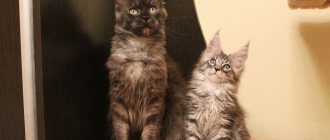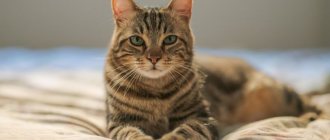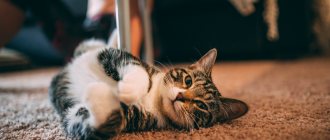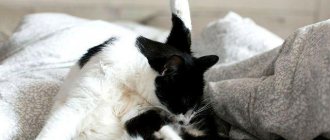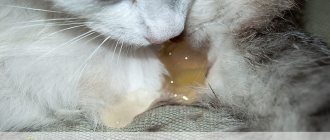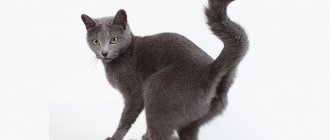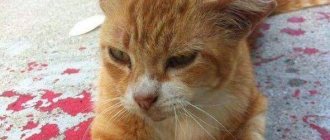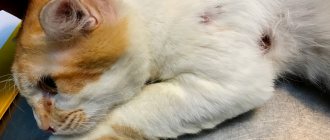Cat owners sometimes notice the appearance of discharge from the external genitalia in their pets. If this discharge accompanies estrus or the cat has recently lambed, there is no need to worry. At the same time, if the discharge does not stop for a long time, has an abnormal color and a pungent odor, then this is a reason for concern and contact a veterinarian.
Discharge from a cat’s genitals can be physiological (normal) or pathological (associated with a disease of the genital apparatus).
Physiological discharge in a cat primarily includes discharge during estrus .
A cat comes into heat when it reaches sexual maturity.
Sexual maturity of a cat. Sexual maturity is a cat's ability to produce offspring. Puberty in a cat is characterized by the formation of eggs in the ovaries and the manifestation of sexual cycles. With the onset of puberty, oogenesis in a cat continues throughout the cat's reproductive life. Puberty in a cat occurs at 4-6 months.
Puberty in a cat always appears earlier than the main growth and development of the animal ends. Therefore, the onset of puberty does not yet indicate the cat’s body is ready to reproduce. Puberty, depending on the conditions of detention, feeding, breed, climatic conditions, occurs in 6-8 months; in large and long-haired breeds (Persians, Maine Coons), maturation begins at the age of 9-12 months. Cat owners need to keep in mind that after puberty, the cat is not yet ready for full reproduction of offspring. If you breed your cat during her first heat, when the cat's body is not yet ready to bear kittens, this will cause a number of problems with her health.
Physiological maturity in a cat, indicating the ability to use it for reproduction without harm to the cat’s health, occurs at the age of 10-15 months.
Estrus is the second stage of the estrous cycle. The cat appears excited with the phenomena of estrus and hunting; in some cats it is accompanied by such strong excitement that the owners involuntarily suspect cat rabies (rabies in cats). The cat refuses food, emits piercing screams - wild meows, arches its back, rolls on the floor, rubs its head and neck on the floor, the ground, moves its tail to the side, strives for the cat and allows it to sit. Discharge during estrus is homogeneous, transparent, without inclusions. The stage of arousal lasts an average of 7-10 days in a cat (5-14 days in the spring and 1-6 days in other periods of the year) - the cat is in heat.
Discharge after childbirth . After giving birth, a cat discharges from the genitals. The first days of discharge are reddish or brown in color, interspersed or streaked with green. Postpartum discharge in a cat should normally last no more than 21 days. The cat's appetite remains good, the cat feels well, and takes full care of her kittens.
Discharge during pregnancy . Discharge during pregnancy in the form of mucus occurs up to 21 days from the onset of pregnancy. Such transparent and viscous odorless discharge indicates the formation of a mucous plug in the cervix, which ensures the normal course of pregnancy and does not allow pathogenic microorganisms to enter the uterus.
Before giving birth, this mucous plug in the cat comes away as a result of the onset of contractions, the discharge becomes yellow, and then bloody (childbirth in a cat).
Signs of estrus
Changes occur in the animal's body. During the period of sexual arousal, the pet suffers from severe hormonal imbalance and psychological distress. How active an animal will be during estrus depends directly on its physical condition.
If the cat is exhausted or, conversely, overfed, then estrus may proceed unnoticed.
© shutterstock
Estrus occurs in several stages, where the period of readiness for mating is only a fragment of the cycle. Estrus consists of the following stages:
- First stage . This period lasts approximately four days. The cat begins to show the first signs. The appetite increases, the pet tries to be with the owner more and asks for affection. If there is a cat in the apartment, then she treats him negatively. Irritability and minor mood swings may occur.
- Second phase . The duration of the period is from one to one and a half weeks. At this time, estrus is pronounced and the process of maturation of follicles ready for fertilization occurs. You definitely won’t miss this stage; the pet constantly purrs and meows, rubs against all objects and surfaces. The fact that a cat is in heat can be understood by its characteristic body movements: it raises its pelvis and falls on its paws with its tail outstretched. If you want to breed a pet, then the third day after the start of this stage will be the most productive.
- Third stage . The duration of the period is approximately ten days. At this time, sexual desire begins to subside. If a pet becomes pregnant, then she develops strong aggression towards cats. If not, then the condition may be different. Sometimes a false pregnancy or calm completion of estrus is noted.
- Fourth stage . The duration is not precisely established. It can be from two weeks to several months. Depends on the living conditions of the animal. At this time, the pet experiences a lull and returns to its usual lifestyle and normal hormonal levels.
On average, a cat's heat lasts from one to three weeks. Prolonged estrus in a cat may indicate physiological abnormalities. The pet needs to be taken to the vet immediately.
Pathological discharge
Pathological discharge in a cat occurs with the following diseases.
Pyometra. Pyometra is an accumulation of purulent exudate in the uterine cavity of a cat. Pyometra affects all cats - both those who have given birth and those who have not. Of course, a cat cannot get pyometra after sterilization, when both ovaries were removed along with the cat’s uterus. If not treated promptly, pyometra can lead to severe septic complications and even death of the cat.
Causes of pyometra in cats. The appearance of pyometra in a cat can be provoked by a number of factors:
Injuries during childbirth, childbirth in unsterile conditions, in violation of the rules of asepsis and antisepsis. Hormonal dysfunction of the ovaries. It develops in cats due to high levels of progesterone and estrogens in the cat’s body; it can develop when taking drugs for estrus (contrasex, anti-sex), etc. With hormonal dysfunction, a cat develops glandular-cystic endometrial hyperplasia, accompanied by the appearance of cysts. The body's defenses are weakened and the cat eventually develops pyometra. Inflammation of the genitourinary system (cystitis, vaginitis, cervicitis, endometritis), in which the inflammatory process from the lower parts of the reproductive system enters the uterine cavity. Uncontrolled matings, matings with an untested cat. Infectious and invasive diseases, the pathogens of which affect the cat’s endometrium (chlamydia in cats).
Signs of pyometra. Pyometra in cats can be open or closed. With an open pyometra, the cervical canal is open and pink or brown purulent contents are discharged from the vulva in large quantities. After lying down, the cat leaves whitish spots on the litter, and body temperature increases by 1 -1.5 ° C. A sick cat develops increased thirst, complete and partial loss of appetite, gastrointestinal upset (diarrhea in cats), and frequent urination. The cat licks its genitals every 20-30 minutes.
With a closed pyometra, upon external examination there is no vaginal discharge because the cervix is closed. In the uterine cavity, purulent exudate accumulates, causing intoxication of the body. Body temperature rises by 1-2°C, the cat has no discharge from the external genitalia, thirst increases greatly, appetite disappears, and the general condition quickly deteriorates. The activity of the gastrointestinal tract is disrupted - diarrhea appears (diarrhea in a cat). Damage to the genitourinary system is accompanied by frequent urination. On palpation, the cat's abdomen is enlarged and tight. The cat develops intoxication of the body, breathing becomes heavy, and there is no reaction to external stimuli.
In some cats, the development of pyometra can occur very rapidly, and the cat may die before the onset of symptoms of the disease characteristic of pyometra. The amount of purulent exudate in the uterine cavity can reach a liter in two days; the thin layers of the uterus cannot withstand the pressure, and pus leaks into the abdominal cavity with the development of purulent peritonitis (pyometra in a cat).
Postpartum vulvitis (inflammation of the vulva), vestibulitis (inflammation of the vaginal vestibule) and vaginitis (inflammation of the vagina).
Etiology. The cause of postpartum vulvitis, vestibulitis and vaginitis is trauma to the cat’s birth canal and its infection during pathological childbirth and inept obstetric care.
Clinical picture. Postpartum vulvitis, vestibulitis and vaginitis can be accompanied by an acute course and can occur in serous, catarrhal, purulent and necrotic forms. The sick animal is worried, arches its back, the cat strains, and we notice frequent urination. The external genital organs with vulvitis are swollen, reddened, with hemorrhages, and with purulent inflammation - often with ulcerations, painful on palpation. Vestibulitis and vaginitis often occur simultaneously and are accompanied by the discharge of exudate from the genital fissure - serous (watery), catarrhal (mucous and cloudy) or purulent (postpartum vulvitis, vestibulitis and vaginitis in small domestic animals).
Vaginitis . Vaginitis is inflammation of the vaginal mucosa. Acute vaginitis most often occurs as a result of trauma during childbirth; chronic vaginitis can be the result of infectious diseases, such as chlamydia (feline chlamydia).
Endometritis . Endometritis is an inflammation of the uterine mucosa. According to the course, endometritis in cats can be acute and chronic. According to the nature of inflammation, endometritis can be catarrhal, catarrhal-purulent, purulent, fibrinous. Acute endometritis in cats that occurs in connection with childbirth is usually called postpartum. Chronic endometritis in cats develops from acute inflammation of the uterine mucosa.
Signs of endometritis. Acute postpartum endometritis in a cat begins 2-5 days after birth. The cat's body temperature rises by 0.5-1°C, the owners of the animal note a decrease or complete loss of appetite, and milk secretion decreases. A characteristic sign of acute postpartum endometritis is mucous or mucopurulent discharge of inflammatory exudate from the genital fissure. Pet owners usually notice exudate from the genitals on the floor in the place where the cat was lying. The cat often assumes a posture to urinate, arching its back and moaning (cat endometritis).
Malignant neoplasms of the genital organs . In case of cancer of the genital organs in a cat, purulent discharge with a foul odor comes from the external genital organs as a result of the destruction of soft tissues (oncology in cats).
Decomposition of the placenta . Sometimes after giving birth, a cat’s placenta does not come out completely; the cat develops watery discharge from the genitals with bloody clots (Placenta retention in small domestic animals).
Bleeding from the uterus . Bleeding from the uterus can occur during childbirth (during the gestation stage and the placenta stage) and in the postpartum period. The vessels of the chorion or the mucous membrane of the uterus or the circulatory systems of the fetus and mother at the same time can be opened into the uterine cavity. Bleeding can be either capillary, venous or arterial.
Etiology. The immediate cause of uterine bleeding is injury to the uterus during obstetric care, especially if it is provided by ignorant personnel; injuries to the uterus may be caused by instruments. In some animals, even complete perforation of the uterine wall may occur during childbirth. Bleeding from the uterine cavity in a cat is especially common when rough surgical separation of the placenta is performed, during which the uterine mucosa is injured. Rarely, bleeding occurs when we try to forcibly expand the cervical canal, with a belated attempt to perform surgical separation of the placenta.
Clinical signs. We talk about bleeding from the uterus when we see periodic or constant discharge of blood from the cat’s genital tract.
If the bleeding in the uterus is profuse, then when the cat strains, the contents of the uterus mixed with blood or pure blood are released from the external genitalia. If the animal is bleeding heavily, we diagnose anemia (anemia in cats).
Blood in the urine or hematuria (Haematuria) in cats is accompanied by the release of some blood when urinating. Hematuria in cats is one of the symptoms of a number of infectious diseases, as well as diseases of the genitourinary system of cats and injuries. Normally, a cat's urine is clear; the color of the urine can vary from light yellow to orange. A healthy cat should have no impurities or blood in its urine. Urine should not have a strong odor.
The cause of blood in a cat's urine may be:
Diseases of the genitourinary system (urethritis, cystitis, urolithiasis, renal lymphosarcoma, polycystic kidney disease, kidney parasites). Damage to internal organs as a result of a fall or injury. Cat worms. Hemolytic poisoning (poisoning of animals with zinc compounds). Infectious diseases (leptospirosis). Invasive diseases (pyroplasmosis). Reaction to the administration of certain medications to a cat. Hypothermia. Poorly performed cat sterilization operation. As a result of uterine bleeding after lambing, during heat and during estrus.
Symptoms of hematuria in cats. The main symptom of hematuria in a cat is the presence of blood in the urine, causing the urine to appear red or brown in color. Additionally, the owner of a cat with severe blood loss notes the appearance of anemia in the cat. The cat experiences painful urination and meows during urination. The act of urination is difficult, the cat hunches its back, the cat urinates in small portions, sometimes past its potty, until urination is delayed. With hematuria, the cat’s general condition is depressed, the cat’s behavior changes (meows loudly, rushes around the room), appetite is reduced, and sometimes vomiting is recorded (blood in the cat’s urine).
Hydrometra - characterized by the accumulation of fluid in the uterine cavity, which is formed as a result of the accumulation of uterine gland secretions and mucous-catarrhal exudate. Occurs as a result of chronic endometritis. The accumulation of transudate up to 10 liters is possible in the uterine cavity. As a result, the wall of the uterus becomes thinner and stretched, and the uterus and ovaries descend into the abdominal cavity. The cat's sexual cycles stop. When the cat's cervical canal is not completely closed, owners note a white or transparent discharge from the external genitalia. In the absence of timely treatment, the cat dies.
First heat
Each female is individual, so the first heat may occur differently for everyone. If there is a genetic predisposition, then maturation will occur very early and vice versa. It depends on the character how vividly and often the female’s sexual cycle will be repeated. If we take the average for all purebred and ordinary animals, then the first heat occurs from seven to ten months. Many kittens at this age are not yet fully formed, so it is impossible to breed a pet during the first heat.
The onset of the first estrus does not mean that the cat’s body is ready to bear full-fledged healthy offspring and not harm the pet itself.
This period begins after the animal reaches the age of thirteen weeks. There are exceptions, breeds for which this period does not occur even longer.
© shutterstock
For breeding breeds, it is very important when the moment of the first sexual heat occurs. If it is too early or, conversely, too late, then the cats are culled and removed from the breeding line. This happens because this uncharacteristic property of the onset of sexual heat can be passed on genetically to descendants.
Medications to calm cats
In addition to all of the above, you can use the following tools:
Cat Bayun is a drug aimed at correcting a cat’s behavior. It is available in the form of tablets and drops, and the product is completely safe for your pet. The composition is represented by natural ingredients (roots of peony, lemon balm, St. John's wort, thyme, sweet clover, valerian and oregano);
Fospasin - used both as injections and drops. The drug alleviates the emotional and psychological state of the animal. The substances contained in Phospasin do not accumulate in the pet’s body, which prevents the occurrence of negative consequences for the cat;
Bach drops - the product does not contain any additives of artificial origin. The drug helps calm the pet without having a depressant effect on its nervous system. The drops do not have a hypnotic effect. Any of the described remedies and injections calms the animal, but the process of estrus does not stop.
Duration and frequency of estrus
The onset of the first sexual activity means that now sexual hunting will take place regularly. How long it lasts and how often it will happen is difficult to say. Each owner should calculate such indicators individually for his pet. The occurrence of estrus in a cat is directly related to the length of the day.
Many pets live under artificial lighting, which makes the period of sexual activity longer and more frequent.
How often estrus can occur depends, for example, on whether there were matings in a previous estrus or whether the female was pregnant. If all cycles have passed without the participation of the cat, then the period may be more frequent and longer.
With age, sexual desire weakens and occurs less frequently. And also in winter, the duration of excitation is minimal . This is due to instincts, because bearing offspring in winter is problematic.
Measures to calm a cat
Regardless of what phase of estrus your pet has entered, you need to take all necessary measures to calm the cat.
These measures include:
- Give your pet as much time as possible - petting, hugging, holding on your hands and knees. Such actions relieve the animal’s stress;
- play as often as possible. So, a new toy will probably interest a cat, it will jump up and run around the apartment with it, which will lead to the release of excess energy;
- During estrus, you need to reduce your pet's diet. Veterinarians say that at this time the cat should not be fed during the day, but should be given food in small quantities at night. But access to water should be unlimited;
- you can include a classical musical composition;
- during the first heat, it is better to isolate your pet in the bathroom or a separate room;
- Some cats are helped by homeopathy;
- The drug "Suprastin" is an excellent remedy for relieving excessive anxiety in an animal during estrus.
